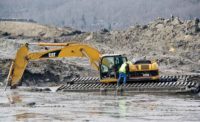EPA Eases Coal-Ash Impoundment Rules
A U.S. Environmental Protection Agency change to its 2015 rule for disposing of coal ash is drawing environmental groups’ ire, but construction officials are more focused on an expected second EPA proposal that could encourage more “beneficial use” of coal ash in concrete and other building materials.
The first amendment, released July 18, extends deadlines for closing unlined leaking storage ponds for coal-combustion residuals, or ash, and gives states more authority to tailor disposal requirements to sites’ varying risks. The changes also allow state officials, rather than professional engineers, to determine whether states are complying with the regulation.
Andrew Wheeler, EPA’s new acting administrator, said the changes are “a significant departure from the one-size-fits-all policies of the past and save tens of millions of dollars in regulatory costs.”
Melinda Tomaino, Associated General Contractors of America director of environmental services, says the July 18 revision won’t have much impact on construction firms. But AGC and the Portland Cement Association (PCA) are awaiting a second EPA amendment expected to be proposed as early as September.
Charles Franklin, PCA vice president of regulatory affairs, says that the current rule limits beneficial use, in which coal ash is recycled into concrete and other materials. The 2015 regulation designates coal ash as a solid waste, which triggers compliance requirements under the Resource Conservation and Recovery Act (RCRA). “It really shouldn’t be treated as a solid waste to begin with,” Franklin says.
He also says EPA acknowledged that it made a mathematical error in calculating the threshold at which compliance requirements kick in. As a result, cement kilns have a limited amount of time and space to store residuals, which discourages widespread ash reuse, he says, adding, “This undermines EPA’s own goals in reducing carbon emissions and encouraging beneficial use of these materials.”
Environmental groups say the ash contaminates water sources and had pushed for it to be designated “hazardous,” triggering more EPA oversight under RCRA. Andrew Rehn of the Prairie Rivers Network added, “We need professional engineers, not political appointees or polluters, making decisions about the safety and cleanup of coal ash.”



